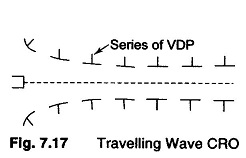High Frequency CRT or Travelling Wave Type CRT:
Figure 7.17 illustrates a High Frequency CRT.
In an ordinary CRO, there is only one pair of VDPs. When the signal to be displayed is of a very high frequency CRT, the electron beam does not get sufficient time to pick up the instantaneous level of the signal. Also, at high frequency CRT the numbers of electrons striking the screen in a given time and the intensity of the beam is reduced. Hence, instead of one set of vertical deflection plates, a series of vertical deflection plates are used.
The plates are so shaped and spaced that an electron travelling along the CRT receives from each set of plates an additional deflecting force in proper time sequence. This synchronization is achieved by making the signal travel from one plate to the next at the same speed as the transit time of the electrons.
The signal is applied to each pair of plates, and as the electron beam travels the signal also travels through the delay lines. The time delays are so arranged that the same electrons are deflected by the input signal. In this way the electron beam picks up the level of the input signal.
The time delays between the plates correspond exactly to the transit times of the electrons. (In addition, new fluorescent materials have now been developed to increase the brightness at HF.)
Characteristics of a HF CRO or (HF Improvement in a CRO):
- The vertical amplifier must be designed both for high B.W. and high sensitivity or gain. Making the vertical amplifier a fixed gain amplifier simplifies the design. The input to the amplifier is brought to the required level by means of an attenuator circuit. The final stages is the push-pull stage.
- The LF CRT is replaced by an HF CRT.
- A probe is used to connect the signals, e.g. a high Z passive probe acts like a compensated attenuator.
- By using a triggered sweep, for fast rising signals, and by the use of delay lines between the vertical plates, for improvement of HF characteristics.
- New fluorescent materials that increase the brightness of the display are used.